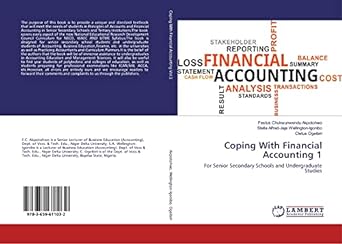Answered step by step
Verified Expert Solution
Question
1 Approved Answer
Castile Products, Inc. Balance Sheet December 31 Assets Current assets: Cash Accounts receivable, net Merchandise inventory Prepaid expenses Total current assets Property and equipment, net

 Castile Products, Inc. Balance Sheet December 31 Assets Current assets: Cash Accounts receivable, net Merchandise inventory Prepaid expenses Total current assets Property and equipment, net Total assets Liabilities and Stockholders' Equity Liabilities: Current liabilities Bonds payable, 10% Total liabilities Stockholders' equity: Common stock, $5 per value Retained earnings Total stockholders' equity Total liabilities and stockholders' equity $ 6,500 35,000 70,000 3,500 115,000 185,000 $300,000 $ 50,000 80,000 130,000 30,000 140,000 170,000 $300,000 Castile Products, Inc. Income Statement For the Year Ended December 31 Sales Cost of goods sold Gross margin Selling and administrative expenses Net operating income Interest expense Net income before taxes Income taxes (308) Net income $ 420,000 292,500 127,500 89,500 38,000 8,000 30,000 9,000 $ 21,000 Account balances at the beginning of the year were: accounts receivable, $25,000; and inventory. $60,000. All sales were on account. Required: Compute the following financial data and ratios: 1. Working capital. 2. Current ratio. (Round your answer to 1 decimal place.) 3. Acid-test ratio. (Round your answer to 2 decimal places.) 4. Debt-to-equity ratio. (Round your answer to 2 decimal places.) 5. Times interest earned ratio. (Round your answer to 2 decimal places.) 6. Average collection period. (Use 365 days in a year. Round your answer to 1 decimal place.) 7. Average sale period. (Use 365 days in a year. Round your intermediate calculations and final answer to 1 decimal place.) 8. Operating cycle. (Round your intermediate calculations and final answer to 1 decimal place.) 1. Working capital 2. Current ratio 3. Acid-test ratio 4. Debt-to-equity ratio 5. Times interest eamed ratio 6. Average collection period 7. Average sale period 8. Operating cycle days days days
Castile Products, Inc. Balance Sheet December 31 Assets Current assets: Cash Accounts receivable, net Merchandise inventory Prepaid expenses Total current assets Property and equipment, net Total assets Liabilities and Stockholders' Equity Liabilities: Current liabilities Bonds payable, 10% Total liabilities Stockholders' equity: Common stock, $5 per value Retained earnings Total stockholders' equity Total liabilities and stockholders' equity $ 6,500 35,000 70,000 3,500 115,000 185,000 $300,000 $ 50,000 80,000 130,000 30,000 140,000 170,000 $300,000 Castile Products, Inc. Income Statement For the Year Ended December 31 Sales Cost of goods sold Gross margin Selling and administrative expenses Net operating income Interest expense Net income before taxes Income taxes (308) Net income $ 420,000 292,500 127,500 89,500 38,000 8,000 30,000 9,000 $ 21,000 Account balances at the beginning of the year were: accounts receivable, $25,000; and inventory. $60,000. All sales were on account. Required: Compute the following financial data and ratios: 1. Working capital. 2. Current ratio. (Round your answer to 1 decimal place.) 3. Acid-test ratio. (Round your answer to 2 decimal places.) 4. Debt-to-equity ratio. (Round your answer to 2 decimal places.) 5. Times interest earned ratio. (Round your answer to 2 decimal places.) 6. Average collection period. (Use 365 days in a year. Round your answer to 1 decimal place.) 7. Average sale period. (Use 365 days in a year. Round your intermediate calculations and final answer to 1 decimal place.) 8. Operating cycle. (Round your intermediate calculations and final answer to 1 decimal place.) 1. Working capital 2. Current ratio 3. Acid-test ratio 4. Debt-to-equity ratio 5. Times interest eamed ratio 6. Average collection period 7. Average sale period 8. Operating cycle days days days


Step by Step Solution
There are 3 Steps involved in it
Step: 1

Get Instant Access to Expert-Tailored Solutions
See step-by-step solutions with expert insights and AI powered tools for academic success
Step: 2

Step: 3

Ace Your Homework with AI
Get the answers you need in no time with our AI-driven, step-by-step assistance
Get Started


